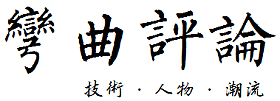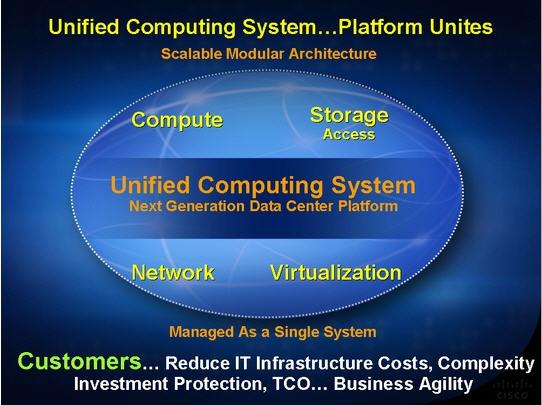思科进军服务器市场–统一计算(Unified Computing System)
作者 陈怀临 | 2009-04-01 15:04 | 类型 行业动感, 读者文摘 | 9条用户评论 »
|
最近,思科高调宣布其统一计算系统战略,进军服务器市场,与IBM,HP,Dell 等正面交锋。可以说,整个计算机产业对思科的寻找新的利润增长点的战略行动都非常震惊和略含恐惧。下面是著名的IT分析媒体ESG的首席分析师Steve Duplessie的分析文章。 另外,读者可通过视频,聆听思科CEO John Chambers对UCS的介绍和理解。 导语:Steve Duplessie,作为ESG 的创始人兼首席分析师,被视为全球数据中心相关技术最权威和最具影响力的IT分析师,在数据中心相关技术的走向和产品化方面也被誉为导航师。他在数据中心方面的观点往往语出惊人,让人耳目一新。近日,思科大张旗鼓,宣布推出统一计算系统(UCS),包括虚拟化技术、各种服务和刀片服务器。此举意味着思科正式进入刀片服务器市场。那么思科的这次作为又将给这个市场带来什么呢?看看ESG怎么来评论吧。 当前,虚拟化解决方案在市场已经得到热捧,客户也都迫切地需要了解其到底能够带来哪些好处,包括提高资源利用率、整合、提高业务连续性以及降低运营开支等。而思科的UCS 就是瞄准新一代数据中心而推出的,旨在为大型企业数据中心提供基础设施,让服务供应商能够将内部云计算扩展到外部厂商。 服务器 思科作为一个新进者,必须向服务器市场证明其产品的高效性和价值。因此,思科必须展示其第一代产品的价值,并证明其能给一个高度虚拟的数据中心带来高效性。新的刀片中心架构具备潜在的内存和I/O优势,这对于大规模扩展的虚拟环境至关重要,但是要让用户充分了解其价值,却需要数百个刀片、数千台虚拟机以及资源密集式环境的配合。事实上,思科在这次发布中还宣称,其将支持的刀片内存量是现有市场产品的3倍来显示UCS对大型企业IT 环境而言将是一个非常诱惑力的平台。 网络 思科将重注压在自有的2个网络先进技术上。第一,思科的UCS Fabric Interconnect负责所有的存储和网络I/O。尽管这项技术还需依赖思科专有的数据中心以太网(DCE),但是它确实能够消除单独的光纤基础设施的需求。为了改善虚拟服务器环境,思科还用自己的虚拟交换机VN-Link取代了VMware的虚拟交换机。如此,思科就能够在系统管理程序内监控虚拟交换,也就统一了物理和虚拟系统之间的网络策略和管理。 存储网络 思科的UCS 采用的是FCoE网络,其扩展性比单个机架要好。FCoE 的应用以及在未有正式标准前就实现产品化,这两项优势给了思科足够的信心,因此其市场的进攻态势显得咄咄逼人,也就不足为奇了。乐观的一面是,预计 2009年底或2010年初可能会出台标准(IEEE Converged Enhanced Ethernet以及T11 FCoE标准)。而比较大的问题在于,只要思科及其合作伙伴一直支持这个产品,那么这个标准对用户来讲是否有意义也就显得无足轻重了。例如,在没有正式的标准时,采用802.11n适配器的笔记本运行也很正常,没有发生过任何问题。虽然将这个网络整合到系统中能够简化安装程序,但是却会使用户只能局限在思科的网络设备上。应该注意的是,UCS 采用的是定制的设备,称之为Fabric Interconnect 和Fabric Extender,没有使用标准的Nexus 5000交换机和2000系列fabric extender。传统的LAN 和SAN 通信可以通过现有的IP 和FC 核心网络来进行。 安全性 尽管这次产品发布没有提及安全性这个因素,但是新的思科技术可能在某些领域会增加风险。如,既然思科的UCS Fabric整合存储和网络I/O,那么一个配置不当或易损的交换机可能将存储网络内的数据泄露。但是这种易损性却没有被最小化,以太网本身就会带来风险,实际上光纤的安全性也有待人们的考证。 虚拟化和云计算 随着越来越多的企业在生产环境中采用虚拟化,以及在新的计算平台部署任务关键性应用,能够快速响应虚拟化的基础设施就成为企业的所需。一个紧密集成的基础设施有助于加快虚拟化的实施,最终让业务驱动带有SLA(服务水平协议)的虚拟基础设施。思科的革新性实现企业对网络、服务器、VMware vSphere智能性(即,VMware的新一代产品)以及其可管理和控制虚拟环境的产品系列的共享。 云服务厂商都看到了广大用户对云计算日益高涨的兴趣,于是他们将内外所有的虚拟机资源集中在一起共享。此外,企业不想或也没有选择,将其应用重新写入以不同的环境,但是他们想要一个更加高效和经济有效的方式来运行应用。最好的解决方案就是,应用根据需要能够透明的在集中的虚拟机资源上运行。思科的UCS 是一种革新性设想,将当前的计算平台变成一个高度动态可快速响应业务需求的平台。 IT 行业总论 思科的UCS发布,给IBM、HP、Sun、Dell带来了新的竞争对手。实际上,思科的UCS架构主要是为针对市场最高端的需求,至少设计初衷是这样的,这意味着Dell 可能能够避免大部分的竞争。Sun对此也不是太关注,因为其只是基于x64的。而IBM 和 HP则是硬碰硬,感受最为深刻的。HP 已经在用其C级刀片的成功应用来应对。在这个市场的高端,至少会造成短暂的震动。HP 已经看到了思科的来势汹汹,也有能够提供竞争性方案的网络设备产品线。既然IBM 和 HP都有自己的存储线产品线,那么他们有机会反击或改变游戏规则。 IBM和HP也在这同一条船上,但是IBM却没有自己的网络设备阵营。HP 和 IBM以及Juniper 和其他厂商将达成新的联盟战线,就像Brocade/Foundry那样,来减少对思科的依赖。IBM和 Juniper已经着手开始筹备了。 也许所有顾虑中,最重要的应该是虚拟化领域,因为思科的举措将加快VMware的部署,而其好像是专为这种应用而开发的。这对整个生态圈内的玩家是个好事,因为它给所有厂商都创造了机会,即使这意味着IBM、HP或Dell可能失去某些刀片和网络业务。更应该关心的应该是,如果思科、 VMware和 EMC携手合作会发生什么,以及这种合作什么时候开始。这样将对整个IT 金字塔顶端的玩家带来更大的潜在影响,而不单单是思科。当然,这也取决于这几家的合作程度。 【注:】 × 此中文翻译稿摘录于中国畅享网 × ESG的英文原稿可参阅如下:
Announcement Details: The Cisco Unified Computing System unites network, compute, and virtualization resources into a single seamless system comprised of: * UCS Manager: Integrated system-level device management. This is imbedded in the UCS Fabric Interconnect. The Cisco UCS consolidates the server and networking infrastructure into common building blocks that tightly integrate with the sever virtualization solution. Overview: Cisco’s entrance into the blade server computing market has the potential to disrupt the current state of the networking, servers and storage markets. * The UCS is a single sourced, scalable computing environment that requires a smaller footprint than traditional systems supporting virtualized environments. Impact to the Market: The current state of the market is red hot with virtualization solutions and customers are eager to seek its benefits, which include improved resource utilization, consolidation, improved business continuity, and reduced operational expenditures. Cisco’s UCS is positioned to be a building block for the next generation data center and is aimed at being the infrastructure for very large enterprise data centers and service providers that are readying themselves for the extension of internal cloud computing out to an external provider. Server: Cisco will have to prove its effectiveness and value as a new incumbent to the server market. The company must demonstrate the value of a first generation product and prove its effectiveness in a highly virtualized data center. The new blade center architecture has potential memory and I/O advantages, which are key in a large scale virtualized environment, but it will take hundreds of blades, thousands of virtual machines, and a resource-intensive environment for customers to fully see the value. The fact that Cisco has announced upcoming support for triple the amount of blade memory versus existing offerings makes the UCS an attractive platform for large environments. Networking: Cisco is betting heavily on two homegrown networking initiatives. First, all storage and network I/O traffic is converged through the Cisco UCS Fabric Interconnect. While this technology depends upon Cisco’s proprietary Data Center Ethernet (DCE), it does eliminate the need for a separate Fibre Channel infrastructure. To enhance the virtual server environment, Cisco replaces the VMware virtual switch with its VN-Link, a softswitch of its own. By doing this, Cisco gains visibility to virtual switching within hypervisors and can thus unify networking policy and management between physical and virtual systems. Storage Networking: Cisco’s UCS utilizes a Fibre Channel over Ethernet network that roughly equates to a top of the rack system—that scales well beyond a single rack. It is not surprising given Cisco’s aggressive stance on FCoE and the general availability of products well in advance of a formalized standard. Best estimates expect the standards to be ratified in late 2009 or early 2010 (both the IEEE Converged Enhanced Ethernet as well as the T11 FCoE standard). The bigger question is whether it matters to users as long as Cisco and its partners support it. Laptop computers have been shipping with 802.11n adaptors for quite some time without formal ratification and there have been no problems. Incorporating this network into the system simplifies the installation process, but locks users into Cisco networking gear. It should be noted that this does not use the standard Nexus 5000 switches and 2000 series fabric extenders, but customized equipment dedicated to the UCS, called the Fabric Interconnect and Fabric Extender. Traditional LAN and SAN traffic can be routed to existing IP and FC core networks. Security: While security is somewhat peripheral to this announcement, new Cisco technology may increase risk in some areas. For example, since Cisco’s UCS Fabric consolidates storage and network I/O, an improperly configured or vulnerable switch could expose data on the data AND storage networks. This vulnerability should not be minimized—Ethernet is a well understood, common threat vector. Fibre Channel is virtually unknown in the security world. Virtualization & Cloud Computing: As more companies adopt virtualization into production environments and deploy mission-critical applications on this new computing platform, they will want an infrastructure that can respond to the highly dynamic nature of virtualization. A tightly integrated infrastructure helps to accelerate the promise of virtualization and ultimately allows businesses drive their virtualized infrastructure with SLAs (service level agreements). Cisco’s innovation enables the company to share networking, and now server, intelligence with VMware vSphere (i.e., VMware’s next-generation products) and its family of products that manage and control the virtualized environment. Cloud service providers are all seeing an uptick in interest around cloud computing and in federating virtual machine resources across internal and external resources. Additionally, companies don’t want to—or don’t have the luxury to—rewrite their applications to run in a different environment, but they do want a more efficient and cost-effective way to deliver applications. The best solution is one that accomplishes both goals where common applications can run transparently across federated virtual machine resources as needed. Cisco’s UCS is an innovative approach by Cisco to make this vision a reality and change the current computing platform into a highly dynamic platform that rapidly responds to business change. IT Industry in General: IBM, HP, Sun, Dell, etc., certainly can’t be happy about this—any legitimate competitive entry is never good news. Realistically, however, the Cisco UCS architecture will be packaged up for the highest end of the market—at least initially—which means Dell should avoid most of the flack. Sun isn’t all that concerned since it’s only x64 based. IBM and HP are the obvious folks to be irritated and affected. This move doesn’t help either, but probably hits HP most notably. HP has been killing with its C-class blade success. At the top of the market, this will cause a hiccup at least—and perhaps much more. HP has seen this coming and has its own line of networking gear from which it can package up competitive solutions. Since both IBM and HP also have storage lines, they will have the chance to deflect or alter the game in some capacity. IBM is in much the same boat, but doesn’t have its own lineup of networking gear. Both HP and IBM will create new alliances with the likes of Brocade/Foundry, along with Juniper and others—and diminish their reliance on Cisco. IBM and Juniper have already started this process. Perhaps the most important all around consideration is in the area of virtualization as this move will accelerate the deployment of VMware, which seems to be almost purpose-built for such uses. That is good for the entire ecosystem of players, since it creates transactions and opportunity all around—even if it means IBM, HP, or Dell lose out on some blade and networking business. A bigger concern, however, is what happens if and when Cisco, VMware, and EMC embark on a real partnership effort. That will have more potential impact at the top of the IT pyramid than Cisco alone, depending, of course, on the level of cooperation. | |
雁过留声
“思科进军服务器市场–统一计算(Unified Computing System)”有9个回复









 (2个打分, 平均:4.50 / 5)
(2个打分, 平均:4.50 / 5)
是否可以看作Xen与VMWarre之间的战争,VMWare的背后有EMC,CISCO等,Xen背后有IBM,HP,SUN等。
希望一个测试出现,Xen、KVM、VMWare、Hyper-V,针对各自的免费版本,整体评估功能性能稳定性可靠性易用性。
不是Xen与VMWare的较量。这这个层面上,XEN,VMWare都是微不足道的。是最微小的一个技术细节。这里的战斗是:提供一个存储+网络的完整解决方案,从而使得企业网络和数据中心的TCO降下来。
您说的是
我刚才思维发散了下,绕到选题去了
不过在思科这个方案里,我认为虚拟化是最关键的要素
是不是可以这么理解思科的思路:思科仍然是倾向于卖设备和软件等实实在在的东西,以前卖的是高性能的路由器,而这次卖的是高性能的数据中心,供一些对于公开的云计算服务的安全问题有顾虑的高级企业用户使用。而Amazon和Google他们仍然走草根路线,他们并不对外提供物理上的数据中心,只是以云计算方式为数以亿计的用户提供服务。所以思科的对手应该是IBM,HP,SUN和EMC,思科的优势在于其高性能的网络可以充分发挥数据中心的优势,但是思科相对于IBM,HP,SUN和EMC方面,其短板在于存储,不知道思科的存储技术是来源自那里?
如果以上分析属实,那么是不是意味着华为和中兴这2个设备巨头可能会很快切入这个领域,至少目前云计算的市场已经在培育当中,4到5年内应该会成熟起来,请怀临大哥谈谈这个问题。
以后我会专题分析思科的UCS。我给大家举一个例子,来看看,如果你是一个CIO,你的痛苦。
你拥有一个数据中心。1,2千台服务器。一栋大楼。6,7个楼层。每个楼层安装rack。每个rack上按标准,安装多少个服务器。
为了这个基本的环境,你需要多少个switch在每一个楼层,每一个楼层那些switch要连接aggregate都更高一级别的switch。switch再aggregate到再一个层次的switch。然后连接到一个高性能的路由器上。
为了安全,你还得购买足够的防火墙设备。VPN设备,Web Acceleartion加速设备等等。。。。
其实,网络设备最后就是算你需要多少个端口和耗电。
这一个设计下来,你要多少钱?你需要什么样的IT的人力和物力来维持这个系统?
你每个月的电费的账单时多少?1年下来,2年下来,10年下来。
这里还根本与什么云计算没有关系。
一切都围绕着TCO(Total Cost of Ownership). 中文的意思就是:拥有的代价。
传闻了一年多,终于出来了. 虽然不叫blade 但相信是Disruptive product!
但相信是Disruptive product!
听说过一个未经证实的数据:
单节点(双CPU,共8核)可配500+G内存
开发模式上,是Cisco “Spin-in -> M&A” 又一成功案例
[...] 惠普在网络设备市场上,目前还处于在低端办公设备型,每年的营收也才10亿美元左右,靠其ProCurve产品线挑战思科这种企业网和核心网上的巨头显然是无能为力的。而思科在今年3月高调宣布其统一计算系统战略,进军服务器市场,与多年的合作伙伴们IBM、惠普、戴尔等正面交锋(参考弯曲评论文章《思科进军服务器市场–统一计算(Unified Computing System)》)。就在前几天,思科还和EMC合作销售数据中心设备。不夸张的说,整个计算机产业对思科的寻找新的利润增长点的战略行动都非常震惊和略含恐惧。 [...]